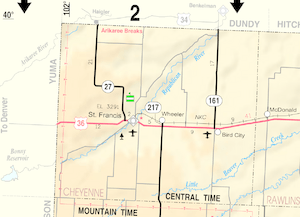Bird City, Kansas facts for kids
Quick facts for kids
Bird City, Kansas
|
|
|---|---|

Location within Cheyenne County and Kansas
|
|

|
|
| Country | United States |
| State | Kansas |
| County | Cheyenne |
| Founded | 1885 |
| Incorporated | 1885 |
| Named for | Benjamin Bird |
| Area | |
| • Total | 2.27 sq mi (5.87 km2) |
| • Land | 2.27 sq mi (5.87 km2) |
| • Water | 0.00 sq mi (0.00 km2) |
| Elevation | 3,468 ft (1,057 m) |
| Population
(2020)
|
|
| • Total | 437 |
| • Density | 192.5/sq mi (74.45/km2) |
| Time zone | UTC-6 (CST) |
| • Summer (DST) | UTC-5 (CDT) |
| ZIP code |
67731
|
| Area code | 785 |
| FIPS code | 20-06825 |
| GNIS ID | 2394172 |
Bird City is a small city in Cheyenne County, Kansas, United States. In 2020, about 437 people lived there. It's a quiet place with a rich history.
Contents
History of Bird City
Bird City was started in 1885. It got its name from Benjamin Bird, who was a cattleman. A cattleman is someone who raises cattle. The land around Bird City was mostly used for raising livestock. Livestock are farm animals like cows.
Bird City was also an important stop on the Chicago, Burlington and Quincy Railroad. This railroad helped transport goods and people.
Geography and Climate
Bird City covers an area of about 2.23 square miles (5.8 square kilometers). All of this area is land.
What is Bird City's Climate Like?
Bird City has a semi-arid climate. This means it's usually dry, but not a desert. It gets some rain, but not a lot. On climate maps, this type of weather is called "BSk."
Population Changes in Bird City
The number of people living in Bird City has changed over the years. Here's a look at how the population has grown and shrunk:
| Historical population | |||
|---|---|---|---|
| Census | Pop. | %± | |
| 1890 | 145 | — | |
| 1900 | 88 | −39.3% | |
| 1910 | 190 | 115.9% | |
| 1920 | 489 | 157.4% | |
| 1930 | 740 | 51.3% | |
| 1940 | 694 | −6.2% | |
| 1950 | 784 | 13.0% | |
| 1960 | 678 | −13.5% | |
| 1970 | 671 | −1.0% | |
| 1980 | 546 | −18.6% | |
| 1990 | 467 | −14.5% | |
| 2000 | 482 | 3.2% | |
| 2010 | 447 | −7.3% | |
| 2020 | 437 | −2.2% | |
| U.S. Decennial Census | |||
Bird City's Population in 2020
In 2020, 437 people lived in Bird City. There were 205 homes and 112 families. Most people living in Bird City were white. About 17% of the population was Hispanic or Latino.
Many homes had people living alone. About 23.6% of the people were under 18 years old. About 24.7% were 65 years or older. The average age in Bird City was 47.8 years.
Education in Bird City
Students in Bird City attend schools in the Cheylin USD 103 public school district. This school district was formed in 1975. It combined the schools from Bird City and McDonald.
The high school for the district is Cheylin High School. Their sports teams are called the Cheylin Cougars. Before the schools combined, Bird City had its own high school. Its mascot was the Cardinals.
See also
- In Spanish: Bird City (Kansas) para niños


